Exergonic reaction - Study guides, Class notes & Summaries
Looking for the best study guides, study notes and summaries about Exergonic reaction? On this page you'll find 854 study documents about Exergonic reaction.
Page 4 out of 854 results
Sort by
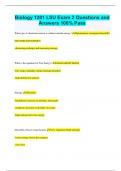
-
Biology 1201 LSU Exam 2 Questions and Answers 100% Pass
- Exam (elaborations) • 14 pages • 2024
- Available in package deal
-
- $9.99
- + learn more
Biology 1201 LSU Exam 2 Questions and Answers 100% Pass What type of chemical reaction is without outside energy? Spontaneous (exergonic/downhill) NOT INSTANTANEOUS -decreasing enthalpy and increasing entropy What is the equation for Free Energy? deltaG=deltaH-TdeltaS -free enrgy=enthalpy-(temp.)(entropy;disorder) -high deltaS=low delta G Entropy Disorder: -breakdown: increase in disorder, more parts -synthesis: decrease in disorder, less parts -high entropy=low free energy ...

-
EXSC 340 Exam 1 Questions with Complete Correct Answers | Grade A+
- Exam (elaborations) • 13 pages • 2024
-
- $11.49
- + learn more
bioenergetics Ans: the flow of energy in a biological system; the conversion of macronutrients into biologically usable forms of energy catabolism Ans: the breakdown of large molecules into smaller molecules catabolism Ans: associated with the release of energy anabolism Ans: synthesis of larger molecules from smaller ones exergonic reaction Ans: energy-releasing reactions that are generally catabolic endergonic reaction Ans: require energy and include anabolic processes and the con...

-
KHP420G Exam Questions with Complete Correct Answers | Grade A+
- Exam (elaborations) • 21 pages • 2024
- Available in package deal
-
- $12.49
- + learn more
coupled reactions Ans: the energy released by an exergonic reaction is used to drive an endergonic reaction exergonic reaction Ans: A chemical reaction that releases energy endergonic reaction Ans: Reaction that absorbs free energy from its surroundings. the breakdown of glucose is what exergonic reaction Ans: an exergonic reaction -forms co2 and water -breaks c6h2o8+6o2 -need atp to make atp 2 Oxidation Ans: loss of electrons reduction Ans: gain of electrons oxidation-reduction...

-
UNCG KIN 375 Exam 1 Questions And Answers Already Graded A+
- Exam (elaborations) • 15 pages • 2024
-
- $8.39
- + learn more
Chapter 2 - ️️ᕦ(ò_óˇ)ᕤ Factors that regulate enzyme activity: - ️️- temperature - pH - substrate concentration - product inhibition - cofactors (cAMP, AMP, calcium, etc. can either activate or inhibit enzyme activity) Gain of a control system - ️️Degree to which a control system maintains homeostasis; a system with an appropriate gain is more capable of maintaining homeostasis than a system w/ low gain Simple biological control system components - ️️- stimulus - ...
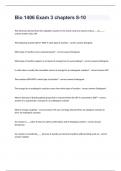
-
Bio 1406 Exam 3 chapters 8-10 questions n answers rated A+
- Exam (elaborations) • 9 pages • 2024
- Available in package deal
-
- $14.99
- + learn more
Bio 1406 Exam 3 chapters 8-10 questions n answers rated A+The electrons derived from this oxidation reaction in the Calvin cycle are used to reduce ___to____ - correct answer CO2, G3P The following reaction AB+C+ HEAT is what type of reaction - correct answer Exergonic What type of reaction occurs spontaneously? - correct answer Exergonic What type of reaction requires a net input of energy from its surroundings? - correct answer Endergonic In cells what is usually the immediate sour...
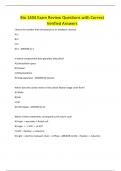
-
Bio 1404 Exam Review Questions with Correct Verified Answers
- Exam (elaborations) • 24 pages • 2024
- Available in package deal
-
- $13.14
- + learn more
Choose the number that corresponds to an exergonic reaction. A) 1 B) 2 C) 3 D) 4 - ANSWER C) 3 In which compartment does glycolysis take place? A) Extracellular space B) Cytosol C) Mitochondrion D) Golgi apparatus - ANSWER B) Cytosol
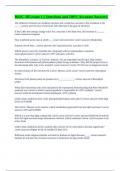
-
BIOC 385 exam 1 || Questions and 100% Accurate Answers.
- Exam (elaborations) • 20 pages • 2024
- Available in package deal
-
- $12.99
- + learn more
The difference between an oxidation reaction and a reduction reaction is that oxidation is the _____ correct answers loss of electrons and reduction is the gain of electrons. If the Gibbs free energy change value for a reaction is less than zero, this reaction is ______ correct answers exergonic Flux is defined as the rate at which ___ is/are interconverted. correct answers Metabolites Enzyme active sites... correct answers Are characterized as a pocket or cleft Which answer correctl...
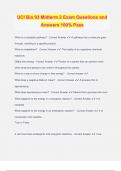
-
UCI Bio 93 Midterm 2 Exam Questions and Answers 100% Pass
- Exam (elaborations) • 15 pages • 2024
- Available in package deal
-
- $12.49
- + learn more
UCI Bio 93 Midterm 2 Exam Questions and Answers 100% Pass What is a metabolic pathway? - Correct Answer ️️ -A pathway that a molecule goes through, resulting in a specific product. What is metabolism? - Correct Answer ️️ -The totality of an organisms chemical reactions Gibbs free energy - Correct Answer ️️ -Portion of a system that can perform work when temp and pressure are uniform throughout the system. What is a way to show change in free energy? - Correct Answer ️️ - ...
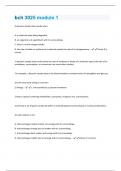
-
bch 3025 module 1 Questions With Correct Answers
- Exam (elaborations) • 8 pages • 2024
- Available in package deal
-
- $7.99
- + learn more
A dynamic steady state results when A. a molecule stops being degraded. B. an organism is at equilibrium with its surroundings. C. there is no net energy transfer. D. the rate of intake or synthesis of a molecule equals the rate of its disappearance - Choice D is correct. A dynamic steady state results when the rate of synthesis or intake of a molecule equals the rate of its breakdown, consumption, or conversion into some other product. For example, a dynamic steady state in the blood ma...
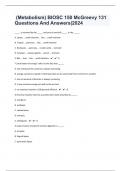
-
(Metabolism) BIOSC 150 McGreevy 131 Questions And Answers|2024 |33 Pages
- Exam (elaborations) • 33 pages • 2024
-
- $10.49
- + learn more
_____ is secreted by the _____ and acts to emulsify _____ in the _____. A. Lipase ... small intestine ... fats ... small intestine B. Trypsin ... pancreas ... fats ... small intestine C. Nucleases ... pancreas ... nucleic acids ... stomach D. Amylase ... salivary glands ... starch ... stomach E. Bile ... liver ... fats ... small intestine - ️️E. "Conservation of energy" refers to the fact that _____. A. the entropy of the universe is always increasing B. energy cannot be created or...

Did you know that on average a seller on Stuvia earns $82 per month selling study resources? Hmm, hint, hint. Discover all about earning on Stuvia


